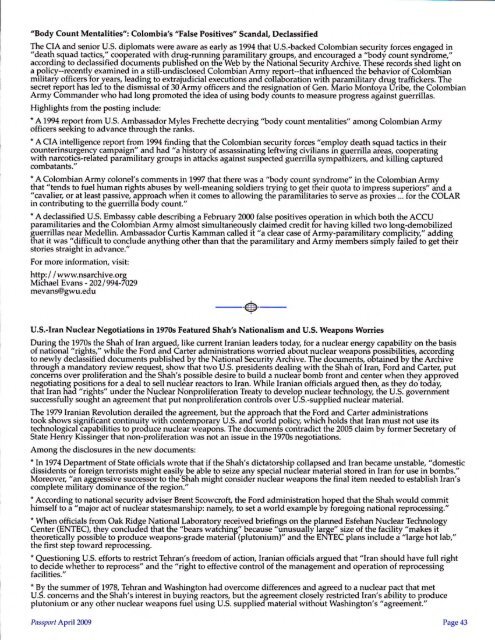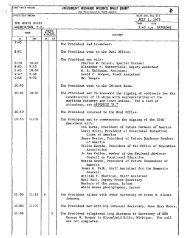Here - Nixon Tapes
Here - Nixon Tapes
Here - Nixon Tapes
- No tags were found...
You also want an ePaper? Increase the reach of your titles
YUMPU automatically turns print PDFs into web optimized ePapers that Google loves.
"Body Count Mentalities": Colombia's "FaIs€ Poeitivee" Scandal, DeclassifiedThe CIA and senior U.S. diplomats were aware as earlv as 1994 that U.S.-backed Colombian securitv forces encaced in"death squad tactics," coor;erated with drug-running iraramilitarv croupt and encouraqed a "bodri count syn-d6me,"accordini to declassified documents published on thleWeb bv thd Natioiral Securiw Arctrive. The# records -shed lisht ona policy-recendy examined in a still-irndisclosed Colombian Armv report-that iMuenced the behavior of Colomb'ianmilitary officers-for years, leadins to exkaiudicial executions and iollaboration with paramilitarv drue traffickers. Thesecret report has ledto the dismidsal of 30'Army officers and the resignation of Gen. Mario Moniova l]ribe, the ColombianArmy Commander who had long promoted the idea of using body c6unts to measur€ progrcss against guerrillas.Hithlights from the posting include:* A 1994 report from U.S. Ambassador Myles Frechette decrying "body count mentalities" among Colombian Armyofficers seeking to advance through the rinks.* A CLA intelligence report from 194 finding that the Colombian security forces "employ death squad tactics in theircounterinsurgEncy carirpaim" and had "a history of assassinating leftwine civilians fn e-uerrilla aieas, cooperaHncwith narcotic-s-related parahilitary groups in attacks against susp;ected gu;rrilla sympaihizers, and killing captu.rEdcombatants."' A Colombian Army colonel's comments in 1997 that there was a "body count svndrome" in the Colombian Armvthat "tends to fuel hirman richts abuses by well-meanine soldiers trvini to set their ouota to impress suoeriors" ahd a"cavalier, or at least passive,-approach wlien it comes to-allowing thil piramilitaries t6 serve as froxies ..L for the COLARin contributing to thi guerrilla'6ody count.". A declassified U.S. Embassy cable describins a February 2000 false positives operation in which both the ACCUparamilitaries and the Colorirbian Armv almdbt simultarieouslv claimed credit for havine killed two lons-demobilizedluerrillas near Medellin. Ambassador Curtis Kamman called ii "a clear case of Armv-paiamilitarv comD'liciw," addineihat it was "difficult to conclude anythinS other than that the paramilitary and Armi inemb€rsiinply lailed to get thEirstories straight in advance."For more information, visit:http:/ / www.nsarchive.orgMithael Evans - 202 l9+7O29mevans@gwu.eduU.S,-Iran Nuclear Negotiations in 1970s Featured Shah's Nationalien and U.S, Weapone WorriesDuring the 1970s the Shah of lran argued, like current Iranian leaders todav for a nuclear energv capability on the basisof national "rishtr" while the Ford aind Carter administrations worried abirut nuclear weaponi'posiibiliti6s, accordincto newly declisified documents published bv the National Securiw Archive. The documeirts, obtained bv tlrc Arddv;throuqh a mandatorv review reqdest, show that tr,vo U.S. oresident6 dealine with the Shah of lran, Ford ahd Carter, Dutconcehrs over prolif6ration and the Shah's possible desire'to build a nucleai bomb front and center when thev appio:vednegotiating politions for a deal to sell nucl6areactors to lran. While lranian officials am.red then, as thev do todivthit Iran hid "riqhts" under the Nuclear Nonproliferation Treaw to develop nuclear tec'hnolosy, the U.Sl sovemnientsuccessfully soufht an agr€ement that put nonproliferation contiols over U.S.+upplied nucleii material. -The 1979 Iranian Revolution derailed the asreement, but the approach that the Ford and Carter administrationstook shows sisnificant continuiw with confemporarv U.S. and*orld policv, which holds that Iran must not use itstechnological iapabilities to proauc€ nuclear #eapoirs. The doclment! coritradict the 2005 claim by former Secretary ofState Heiry Kissinger that nbn-proliferation was hot an issue in the 1970s negotiations.Among the disclosures in the new documents:' In 1974 Department of State officials wrote that if the Shah's dictatorship collapsed and lran became unstable, "domesticdissidents oi foreim terrorists might easily be able to seize any special nuclear material stored in lran for use in bombs."Moreover, "an agglressive successdr to theShah might consideir nuclear weapons the final item needed to establish lran'scomplete militaf-dominance of the rcgion."* According to national security adviser Brent Scpwcr,oft, the Ford administration hoped that the Shah would commithimself to i "major act of nucl6ar statesmanship: namely, to set a world example by foregoing national reprocessing."* When officials from Oak Ridee National Laboratorv received briefines on the planned Esfehan Nuclear TedrnoloevCenter (ENTEC), they concluded that the "bears wafthinC'because "[nusuallilarse" size ofthe facilitv "makes it-'theo-rctically possibld to produce weapons-grade material(plutonium)" and thb ENTEC plans include d "laqge hot lab,"the first step toward reprcc€ssing.' Questioning U.S. efforts to rcstrict Tehran's fieedom of action, Iranian officials argued that "lran should have full rightto decide whEther to reprocess" and the "right to effective control of the managem-ent and operation of reprocessing-facilities."* By the summer of 1978, Tehran and Washington had overcome differences and asreed to a nuclear pact that metU.S. concems and the Shah's interest in buviie rcactors, but the asr€ement closelirestricted lran's abilitv to produceplutonium or any other nuclear weapons luel-using U.S. suppliedmaterial witholt Washington's "agreehenl."P,rsspor, April 2009 Page 43






